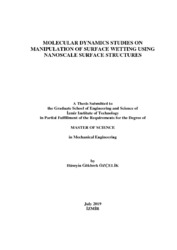Please use this identifier to cite or link to this item:
https://hdl.handle.net/11147/7408Full metadata record
| DC Field | Value | Language |
|---|---|---|
| dc.contributor.advisor | Barışık, Murat | - |
| dc.contributor.author | Özçelik, Hüseyin Gökberk | - |
| dc.date.accessioned | 2019-12-02T06:51:15Z | |
| dc.date.available | 2019-12-02T06:51:15Z | |
| dc.date.issued | 2019-07 | - |
| dc.identifier.citation | Özçelik, H. G. (2019). Molecular dynamics studies on manipulation of surface wetting using nanoscale surface structures. Unpublished master's thesis, İzmir Institute of Technology, İzmir, Turkey | en_US |
| dc.identifier.uri | https://hdl.handle.net/11147/7408 | - |
| dc.description | Thesis (Master)--Izmir Institute of Technology, Mechanical Engineering, Izmir, 2019 | en_US |
| dc.description | Includes bibliographical references (leaves: 41-44) | en_US |
| dc.description | Text in English; Abstract: Turkish and English | en_US |
| dc.description.abstract | The discovery of the lotus effect relating to the hydrophobic nature of lotus leaves is significant to surface structures on wetting. By considering the lotus effect, efforts have been made to mimics the effect of surface stuctures to manipulate wetting and surface patterning is introduced to capture underlying mechanism of lotus effect. Later, the effect of nanosized structures on rose petals is also addressed. Interestingly, while both lotus leaf and rose petal show hydrophobic behavior, due to nanosized structures, rose petals exhibit sticky behavior in contrast to the slippery lotus leaves. Herein, to investigate the effect of nanosized surface structures on wetting, molecular dynamics studies on wetting of nanopatterned silica surfaces are performed. Before performing wetting studies on the surfaces, ab initio based calcuations and molecular dynamics studies are conducted to assure modelled surfaces capture wetting behavior of silica surfaces and it is found that ab inito based calculations overestimate the interactions between water and silica surfaces. Consequently, parametric molecular dynamics studies are performed and force field parameters capturing wetting behavior of silica surfaces are proposed. Then, two different silica surfaces are subjected to investigation and applicability of models predicting contact angle is examined. Previous models proposed in the literature fail in predicting contact angle on nanopatterned silica surfaces. Therefore, initially, averaged water density inside the cavity is considered to characterize wetting behavior but significant variation from trendline is observed. Then, non dimensional surface parameter is proposed to capture wetting on nanopatterned silica surfaces and change in the work of adhesion is correlated with non dimensional surface parameter. | en_US |
| dc.description.abstract | Lotus yapraklarının hidrofobik doğası ile ilgili lotus etkisinin keşfi, ıslanma üzerindeki yüzey yapıları için önemlidir. Lotus etkisi göz önünde bulundurularak, ıslatma davranışını manipüle etmek için yüzey yapılarının etkisini taklit etmeye yönelik çabalar gösterilmiştir ve lotus etkisinin altta yatan mekanizmasını yakalamak için yüzey desenleme uygulanır. Daha sonra, nano-boyutlu yapıların gül yaprağı üzerindeki etkisi değinilmiştir. İlginç bir şekilde, hem lotus yaprağı hem de gül yaprağı, nano boyutlu yapılar nedeniyle hidrofobik davranış sergilerken, gül yaprakları kaygan nilüfer yapraklarının aksine yapışkan davranış sergiler. Burada, nano-boyutlu yüzey yapılarının ıslatma üzerindeki etkisini araştırmak için nano-desenlenmiş silika yüzeylerin ıslatılması üzerine moleküler dinamik çalışmaları gerçekleştirilmiştir. Yüzeylerde ıslatma çalışmaları yapılmadan önce, modellenen yüzeylerin silika yüzeylerinin ıslanma davranışını yakalamasını sağlamak için ab initio esaslı hesaplamalar ve moleküler dinamik çalışmaları gerçekleştirilmiştir ve ab inito esaslı hesaplamaların su ve silika yüzey arasındaki etkileşimi yüksek tahmin ettiği bulunmuştur. Dolayısıyla parametrik moleküler dinamik çalışmaları yapılmış ve silika yüzeylerin ıslanma davranışını yakalayan kuvvet alanı parametreleri önerilmiştir. Daha sonra, iki farklı silika yüzeyi araştırmaya tabi tutulmuştur ve temas açısını tahmin edebilen modellerin uygulanabilirliği incelenmiştir. Literatürde önerilen önceki modeller nano desenlenmiş silika yüzeylerde temas açısını tahmin etmekte başarısız olmaktadır. Bu nedenle, başlangıçta, oyuk içindeki ortalama su yoğunluğunun ıslatma davranışını karakterize ettiği düşünülmüştür, ancak trend çizgisinden önemli farklılıklar gözlenmiştir. Daha sonra, nano desenlenmiş silika yüzeylerde ıslanmayı yakalamak için boyutsuz yüzey parametresi önerilmiştir ve adezyon işindeki değişim, boyutsuz yüzey parametresi ile ilişkilendirilmiştir. | en_US |
| dc.description.sponsorship | TUBITAK (217M460) | en_US |
| dc.format.extent | ix, 44 leaves | - |
| dc.language.iso | en | en_US |
| dc.publisher | Izmir Institute of Technology | en_US |
| dc.rights | info:eu-repo/semantics/openAccess | en_US |
| dc.subject | Molecular dynamics | en_US |
| dc.subject | Biomimetic surfaces | en_US |
| dc.subject | Surface patterning | en_US |
| dc.subject | Wetting of nanopatterned surfaces | en_US |
| dc.title | Molecular Dynamics Studies on Manipulation of Surface Wetting Using Nanoscale Surface Structures | en_US |
| dc.title.alternative | Nano Ölçekli Yüzey Yapıları Kullanarak Yüzey Islatma Manipülasyonu Üzerine Moleküler Dinamik Çalışmaları | en_US |
| dc.type | Master Thesis | en_US |
| dc.institutionauthor | Özçelik, Hüseyin Gökberk | - |
| dc.department | Thesis (Master)--İzmir Institute of Technology, Mechanical Engineering | en_US |
| dc.relation.tubitak | info:eu-repo/grantAgreement/TUBITAK/MAG/217M460 | - |
| dc.relation.publicationcategory | Tez | en_US |
| dc.identifier.wosquality | N/A | - |
| dc.identifier.scopusquality | N/A | - |
| item.openairecristype | http://purl.org/coar/resource_type/c_18cf | - |
| item.languageiso639-1 | en | - |
| item.openairetype | Master Thesis | - |
| item.grantfulltext | open | - |
| item.fulltext | With Fulltext | - |
| item.cerifentitytype | Publications | - |
| Appears in Collections: | Master Degree / Yüksek Lisans Tezleri | |
Files in This Item:
| File | Description | Size | Format | |
|---|---|---|---|---|
| T001967.pdf | MasterThesis | 3.36 MB | Adobe PDF |  View/Open |
CORE Recommender
Page view(s)
246
checked on Mar 31, 2025
Download(s)
108
checked on Mar 31, 2025
Google ScholarTM
Check
Items in GCRIS Repository are protected by copyright, with all rights reserved, unless otherwise indicated.